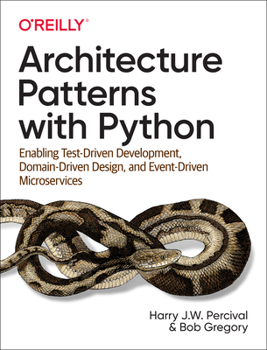Architecture Patterns with Python: Enabling Test-Driven Development, Domain-Driven Design, and Event-Driven Microservices
As Python continues to grow in popularity, projects are becoming larger and more complex. Many Python developers are taking an interest in high-level software design patterns such as hexagonal/clean architecture, event-driven architecture, and the strategic patterns prescribed by domain-driven design (DDD). But translating those patterns into Python isn't always straightforward.
With this hands-on guide, Harry Percival and Bob Gregory from MADE.com introduce proven architectural design patterns to help Python developers manage application complexity--and get the most value out of their test suites.
Each pattern is illustrated with concrete examples in beautiful, idiomatic Python, avoiding some of the verbosity of Java and C# syntax. Patterns include: Dependency inversion and its links to ports and adapters (hexagonal/clean architecture) Domain-driven design's distinction between Entities, Value Objects, and Aggregates Repository and Unit of Work patterns for persistent storage Events, commands, and the message bus Command-query responsibility segregation (CQRS) Event-driven architecture and reactive microservices
With this hands-on guide, Harry Percival and Bob Gregory from MADE.com introduce proven architectural design patterns to help Python developers manage application complexity--and get the most value out of their test suites.
Each pattern is illustrated with concrete examples in beautiful, idiomatic Python, avoiding some of the verbosity of Java and C# syntax. Patterns include: Dependency inversion and its links to ports and adapters (hexagonal/clean architecture) Domain-driven design's distinction between Entities, Value Objects, and Aggregates Repository and Unit of Work patterns for persistent storage Events, commands, and the message bus Command-query responsibility segregation (CQRS) Event-driven architecture and reactive microservices
Format:Paperback
Language:English
ISBN:1492052205
ISBN13:9781492052203
Release Date:April 2020
Publisher:O'Reilly Media
Length:301 Pages
Weight:1.10 lbs.
Dimensions:0.8" x 6.9" x 9.1"
Customer Reviews
0 rating





